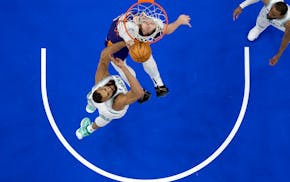When the Gophers signed junior college running back Kobe McCrary earlier this year, he seemed destined for little more than a short-yardage role, as a bigger-bodied option behind Shannon Brooks and Rodney Smith.
Brooks and Smith led the Gophers in rushing last season by a wide margin as freshmen, so there was no sign of that equation changing for a few years. Brooks was option 1A, Smith 1B, with few leftover carries for anyone else, if they were healthy.
But Brooks broke a foot during training camp, and has only recently been cleared for practice. The Gophers plan to be cautious with him against Colorado State on Saturday, knowing McCrary has emerged as a legitimate option 1C.
A Florida native, McCrary opened eyes with his 17-carry, 176-yard performance against Indiana State. He might be a 6-1, 235-pound load, but as the Sycamores learned, he has good vision and cutting ability, too.
"That's what I wanted to prove," McCrary said. "I kind of model my game after Le'Veon Bell. He's a bigger back who can do a lot of stuff. So can David Cobb, too."
The 6-1, 230-pound Bell steamrolled the Gophers and other Big Ten teams for Michigan State before moving on to stardom for the Pittsburgh Steelers. And the 5-11, 230-pound Cobb set Minnesota's single-season rushing record, with 1,626 yards two years ago.
McCrary started hearing comparisons to Cobb on his recruiting visit. Several people noted how much those two look alike, but McCrary said he wanted to play like Cobb, too.
After getting just two carries in the season opener against Oregon State, McCrary got a longer look against Indiana State, reeling off a 43-yard run followed by a 50-yard touchdown. His 176 rushing yards were the fourth-highest total for a Gopher at TCF Bank Stadium; the top three spots all belong to Cobb.
"Watching him run, everything he does is so similar to Cobb," quarterback Mitch Leidner said. "For how big he is, he's going to make people miss."
McCrary was a first-team all-state running back and a state champion basketball player at Chipley (Fla.) High School. He went to Butler (Kan.) Community College, where he played sparingly as a freshman before rushing for 1,190 yards and 22 touchdowns in 11 games last season.
Junior college transfers try to graduate in December, so they're eligible for spring practice at their new school. McCrary had to wait to graduate from Butler until spring semester. Some teams couldn't wait on him, but the Gophers are glad they did.
McCrary arrived with two years of eligibility remaining. He said he knew Brooks and Smith were good but figured he could help create "a three-headed monster."
Redshirt freshmen James Johannesson and Jonathan Femi-Cole sit behind all three of them on the depth chart.
The Gophers saw the value of a crowded backfield during the Glen Mason years. They had three eventual NFL running backs on the same team in 2003 in Thomas Tapeh, Marion Barber and Laurence Maroney. With Brooks healthy, how will Claeys keep everyone happy?
"By winning, that's how," the coach said.
Claeys said the Gophers continue to explore ways to get two of these tailbacks on the field at the same time. The team has shown it can successfully split carries between two running backs, but what about three?
"I don't know," Claeys said. "That's a good question. We'll find out. And it'll be whoever practices the best that week, that's who we'll go with. Competition just makes you a lot better. To think they're all three going to stay healthy all year long, I think that's unrealistic."
Injuries might be inevitable, but McCrary has added depth, and then some.

Reusse: How bad are the White Sox? They made Twins look good.
NFL draft has been on tour for a decade and the next stop is Detroit, giving it a shot in spotlight

Souhan: Wolves fans made Game 1 special. Now bring on Game 2.

Will Wolves show best-in-the-NBA defensive form in Game 2?
